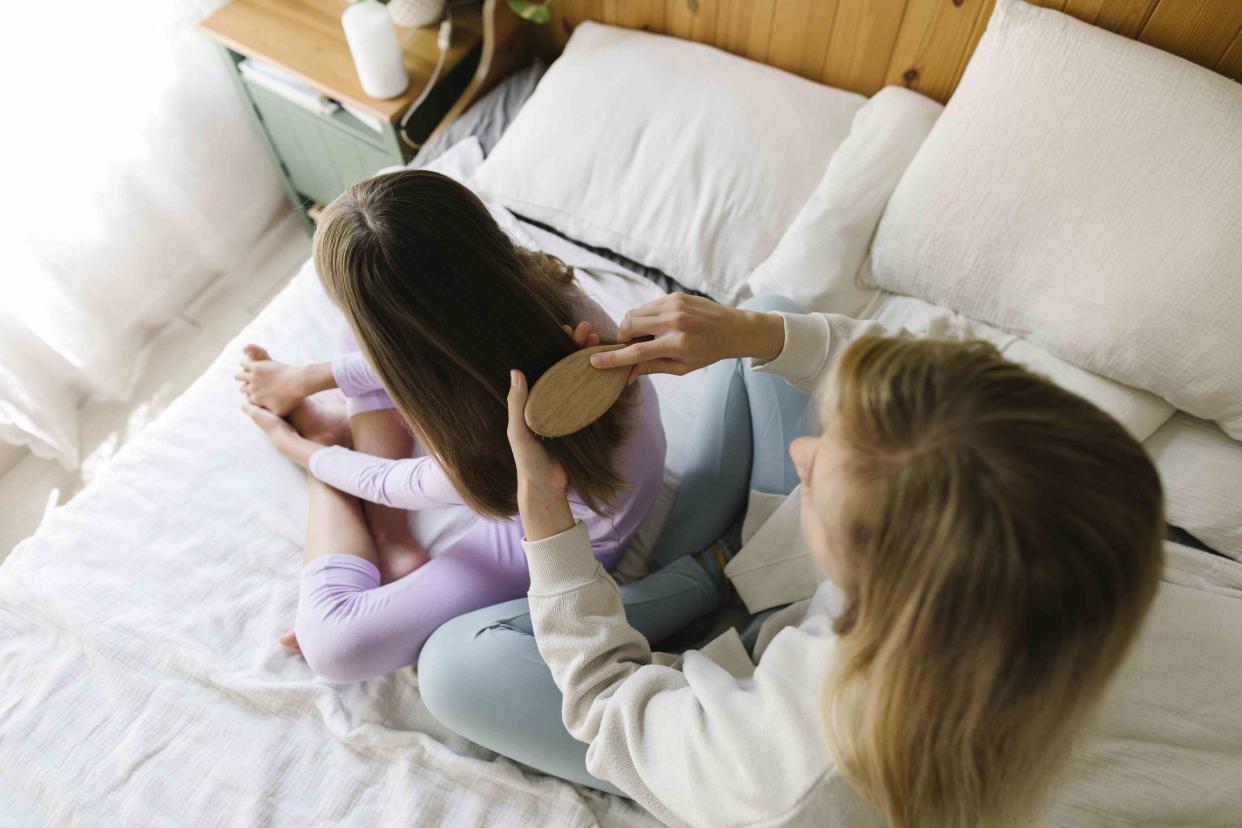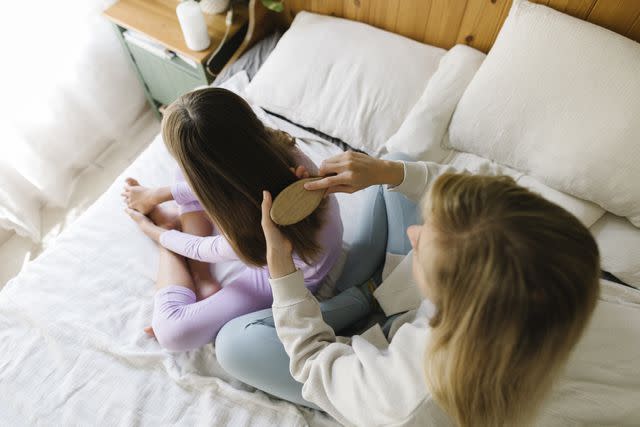Coarse Hair Causes and Fixes

Medically reviewed by Susan Bard, MD
For many people, coarse hair is their natural texture and is neither a cause for concern nor requires treatment. However, in some cases, coarse hair can be caused by damage to the hair shaft, medical conditions, genetic disorders, or other factors.
This article will discuss what can cause coarse hair and how coarse hair can be treated if necessary.

Coarse hair tends to:
Have a thick diameter with a rough texture you can feel when you hold a strand between your fingertips.
Cover the scalp so that little to no scalp is visible when you pull a handful of your hair to the side.
Stretch and return to its initial length when a strand is gently stretched with your fingers.
Coarse hair that is damaged or a result of a medical condition may have additional symptoms, such as easy breakage or atypical growth patterns.
Causes of Coarse Hair
Coarse hair is often simply a person's natural hair texture, largely influenced by genetic factors such as family characteristics and ethnic backgrounds.
When coarse hair is an abnormal feature for a person, it can be caused by several factors, which are outlined below.
Damage to the Hair or Hair Shaft
Structural abnormalities of the hair shaft can result from a medical condition or be acquired through damage such as from an injury.
Overprocessing hair can also damage the hair shaft, including:
Permanent waves/permanent hair straightening
Coloring
Excessive heating
Medical Conditions
Medical conditions such as hypothyroidism (when the thyroid doesn't make adequate levels of thyroid hormones) can be associated with hair changes, including coarse hair.
Changes that come with aging, such as hormonal changes, can also cause hair to become more coarse, particularly for women around age 30 to 40.
Genetic Disorders
Several genetic syndromes cite unusual hair texture as a symptom. These syndromes involve variants in genes that contribute to hair structure and stability. Researchers suggest the genes involved with these disorders likely also influence normal hair thickness and texture variations.
Genetic disorders that may have coarse hair as a symptom include:
Woolly hair: A group of disorders (including subtypes hereditary woolly hair, familial woolly hair, and woolly hair nevus) characterized by coarse, kinked, short, tightly curled hair which is often blond or lighter than that of their family members. It may present as an isolated condition or as part of another syndrome.
Uncombable hair syndrome: A childhood condition characterized by dry, frizzy, light-colored hair that grows out of the scalp in multiple directions instead of downward and cannot be combed flat. It usually improves over time, typically by adolescence.
Menkes disease (Menkes syndrome): A genetic condition affecting copper transport and body maintenance. Characterized by coarse, kinky hair and failure to grow/thrive. Occurs mainly in male infants.
Occipital horn syndrome (x-linked cutis laxa): A less severe form of Menkes syndrome. Symptoms include wedge-shaped calcium deposits in the occipital bone (bone at the base of the skull), coarse hair, and loose joints and skin. Begins in early to middle childhood.
Medications That Can Cause Coarse Hair
The effect of medications on hair is understudied, underreported, and often anecdotal. For example, the term "chemo curl" was coined by people who have been through chemotherapy to describe the tendency for hair lost during chemo treatment to grow back curly, kinky, or wavy.
A 2022 study found that hair texture changes could be potential side effects of medications such as:
Antineoplastics: Cancer medications such as chemotherapy
Antiepileptics: A type of medication used to treat or prevent seizures
Retinoids: Used for skin conditions such as acne or wrinkles
Immunomodulators: Medications that stimulate or suppress the immune system
Antiretroviral therapy: Used to treat human immunodeficiency virus (HIV)
Body hair density varies by ethnicity, family characteristics, and individual. More hair in areas such as the arms, hands, legs, and feet for any gender is usually due to genetic or ethnic variation rather than a medical condition.
Excess growth of coarse, usually dark hair for women in areas found primarily in men (such as the face, chest, inner thighs, abdomen, or back) is called hirsutism and can indicate an underlying condition.
Conditions associated with hirsutism include:
Cushing’s syndrome
Adrenal hyperplasia
Hyperinsulinaemia
Hyperprolactinaemia
Use of certain medications (such as anabolic steroids)
How to Treat Coarse Hair
There is no specific treatment for structural hair disorders caused by genetic conditions. Depending on the condition, symptoms may improve with age.
Treating the underlying cause of coarse hair and changing grooming habits that cause damage may help.
Whether coarse hair is your natural texture or a symptom of an underlying condition, there are care practices that can help manage it. These are outlined below.
Wash Your Hair With Conditioner
If you have coarse hair, you can try washing your hair with conditioner only, called co-washing. This process is gentle on the hair, offering more moisture to lock in.
Apply an Oil Mask
Adding an oil mask, like coconut oil, helps the hair follicle retain moisture. Do this on your wet hair, otherwise, it can make your hair look greasy.
Audit Your Haircare Products
Try to avoid alcohol in your haircare products. Many hair sprays and gels contain alcohol, which can strip your hair of moisture.
It is common for Black people to have coarse hair. Black hair can also be fragile and prone to damage. The American Academy of Dermatology Association recommends these tips for everyday care of Black hair:
Wash hair once a week or once every other week
Use a conditioner with every hair wash, particularly on the ends
Use a hot oil treatment twice per month
Apply a heat-protecting product to wet hair before styling to minimize heat damage
Go to a professional hair stylist if you choose to use relaxers. Get touch-ups only to new hair, and no more than every two to three months
If thermally straightening your hair, use ceramic combs or irons at the lowest effective temperature and no more than once a week
Watch that braids, cornrows, or weaves are not too tight (if it hurts, it is being damaged)
Are There Tests to Diagnose the Cause of Coarse Hair?
If it is suspected that your coarse hair is due to an underlying cause, your healthcare provider may:
Get a detailed medical and family history
Do a physical examination of your hair and other structures such as nails, sweat glands, and sebaceous glands
Use dermoscopic devices such as a dermoscope or a trichoscope to get microscopic views of the hair, scalp, and skin
Run tests related to the suspected underlying cause (such as blood test to check thyroid levels, or genetic testing to look for possible genetic conditions)
If warranted, refer you to a specialist such as a dermatologist or genetics specialist
Summary
Coarse hair is hair that has a wide diameter. It can be a natural, normal hair texture or an indication of an underlying condition.
Abnormal coarse hair may be associated with damage to the hair shaft, medical conditions such as hypothyroidism, aging, or a genetic condition.
Some medications, such as chemotherapy, can also change hair texture.
There is no treatment for structural hair disorders caused by genetic conditions. Some medical conditions associated with coarse hair can be treated. Following care tips for coarse hair is beneficial whether the coarse hair is the natural texture or due to another cause.
See your healthcare provider if you notice changes to your hair, such as the development of coarse hair.

